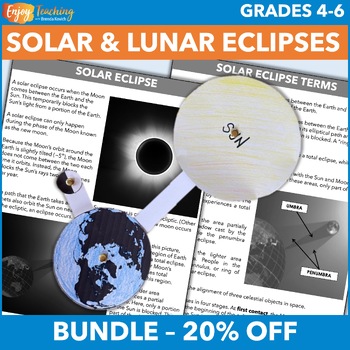2024 Total Solar Eclipse Science Activities for Fourth, Fifth, or Sixth Grade
- Zip
- Easel Activity
What educators are saying
Products in this Bundle (2)
Bonus
Description
Ready to teach the 2024 total solar eclipse? A moveable model, teaching tips, reading passages and questions, map, and observation booklet let you teach science like a pro! Your fourth, fifth, or sixth grade students will love the hands-on activities. You’ll love how quickly they understand complex concepts.
Open the previews to take a closer look. You’ll also receive two bonus files:
- A handy website with links to articles, activities, and videos
- An observation booklet and 2024 total solar eclipse map project
Earth-Moon-Sun System Model
First, build the model.
- Print the templates on card stock.
- Have kids cut out the pieces (and color, if desired).
- Ask them to connect the strips and pieces with two metal fasteners.
Second, guide kids as they explore relative motion and position of the Earth, Moon, and Sun. Talking points provide the support you need to discuss a variety of phenomena:
- Phases – new moon, waxing crescent, first quarter, waxing gibbous, full moon, waning gibbous, third quarter, waning crescent
- Lunar and solar eclipses
- Tides
As a culmination, ask your fourth, fifth, or sixth grade students to review and take a quiz.
Informational Texts and Questions (Full-Page or Booklet)
Nine one-page informative passages provide facts about the Sun and Moon, solar and lunar eclipses, phases, as well as their sizes and positions relative to Earth. Questions and answers correspond to the informational texts. Resources are available in two formats: full-page or foldable booklet (printed back-to-back, it uses just three sheets of paper).
The Sun
- Is the star, or glowing ball of gas, of our solar system
- Gives heat and light; makes life on Earth possible
- Made of three layers: core, radioactive zone, convective zone
- Has atmosphere with three layers: photosphere, chromosphere, corona
- Measures 864,575 miles in diameter
- Holds orbit of Earth at an angle, which causes seasons
The Moon
- Orbits the Earth about once every 27 days
- Can be seen due to reflected light from Sun
- Measures 2,160 miles in diameter
- Made of rock in layers: core, mantle, and crust
- Has a thin atmosphere which allowed meteors to strike the lunar surface
Phases of the Moon
- Are caused by relative position of Earth and Sun
- Include new, waxing crescent, first quarter, waxing gibbous, full, waning gibbous, third quarter, and waning crescent
Solar Eclipses
- Occur when Moon comes between Earth and the Sun
- Include an umbra and penumbra, which determine if it will be total
- Can only occur during a new moon; however, only when on the ecliptic
- Involve specific vocabulary terms: total, annular, hybrid, and partial eclipses; umbra, penumbra, and antumbra; syzygy; first, second, third, and fourth contact
Lunar Eclipses
- Occur when the Earth comes between the Moon and Sun
- Can only occur (total) during a full moon
- Appears red due to long wavelengths (Blood Moon)
- Can be viewed from anywhere on the dark side of Earth, where night is occurring
Relative Sizes
- The Moon is about one-fourth as wide as Earth.
- The Sun is more than 100 times as wide as our planet.
Relative Positions
- The Moon revolves around Earth once every 27.3 days in a nearly circular orbit. It’s about 238,900 miles away.
- The Earth travels around the Sun once every 365.25 days. Its elliptical orbit lies on the ecliptic plane. At its closest point (perihelion), it is 91 million miles away. At its farthest (aphelion), it’s 94.5 million miles from our planet.
Questions and answer keys reflect information in the reading passages.
2024 Solar Eclipse Website
This free website provides a curated list of activities, links, safety, and videos. Open the file and enjoy an organized set of ideas at your fingertips.
Bonus File
As a bonus, you’ll also receive additional materials.
- 2024 total solar eclipse observation book
- Map of the event
- Template for decorating viewing glasses
These resources let you teach science like a pro!
- Directions, FAQs, information sheets, and talking points give you the support you need.
- A moveable model, talking points, worksheets, and reading passages provide comprehensive student resources.
Enjoy teaching!
Brenda Kovich
Note: These resources replace files that previously focused on the 2017 solar eclipse.
Upcoming Lunar Eclipses
- September 17-18, 2024 (partial) - North America, South America, Europe, Africa, western Asia
- March 13-14, 2025 (total) - Europe, Asia, South America
- September 7-8, 2025 (total) - Europe, Asia, Australia, Africa, western north America, eastern South America
Upcoming Solar Eclipses
- April 8, 2024 (total) - best seen in North America
- October 2, 2024 (annular) - best seen in South America
- March 29, 2025 (partial) - best seen in North America, Europe, northern Asia, northwest Africa
- September 21, 2025 (partial) - best seen in southern Australia





